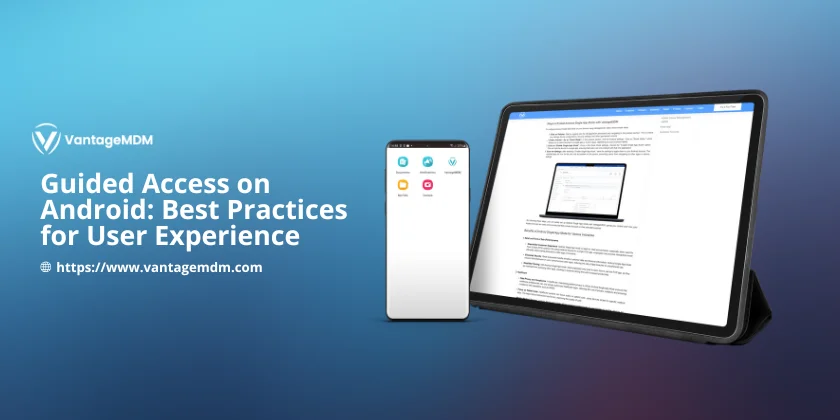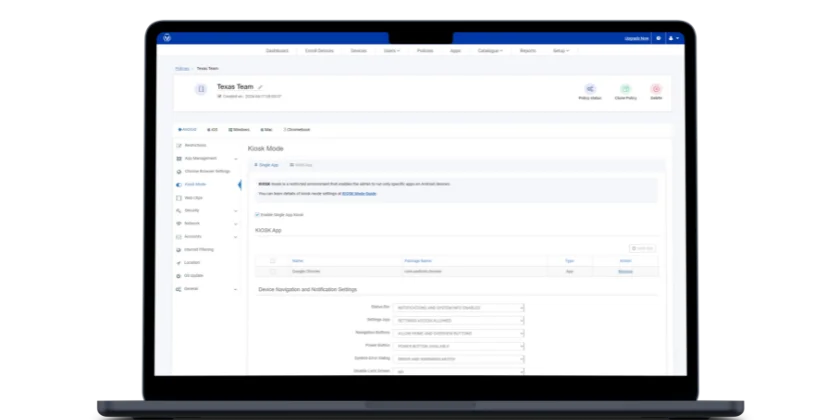Guided Access on Android: Best Practices for User Experience

Guided access Android is a powerful tool that helps create a secure and focused environment on your devices. Whether you’re managing devices in an educational institution, a corporate setting, or using them for public kiosks, guided access on Android offers a streamlined experience that limits distractions and protects sensitive data. This article explores best practices for implementing guided access on Android, provides a detailed overview of the steps most commonly followed, and outlines two approaches: one without an MDM solution and another that integrates a Mobile Device Management (MDM) solution like VantageMDM.
Understanding Guided Access on Android
Guided access on Android is designed to restrict device usage to a single application or a predetermined set of applications. By doing so, it prevents users from navigating away from the app and accessing other parts of the device, which is especially useful in settings where you need to maintain strict control over device functionality. For example, in a retail kiosk environment, guided access Android ensures that customers interact solely with a specific product display app. In educational settings, it can keep students focused on a learning application, free from distractions such as games or social media.
The benefits of guided access on Android are numerous. It enhances device security by preventing unauthorized access to other apps or system settings, simplifies the user interface for those who might be overwhelmed by complex menus, and provides a controlled environment that supports the primary objective of the device. When configured properly, guided access on Android can be a cornerstone of your digital security and user experience strategy.
Best Practices for Implementing Guided Access on Android
To maximize the benefits of guided access on Android, consider these best practices:
- Define Clear Objectives and Use Cases
Before deploying guided access on Android, identify your primary objectives. Ask yourself whether you need to restrict devices for kiosk displays, secure work environments, or focused educational sessions. Clearly defining these use cases will help tailor your guided access configuration to meet your specific requirements.
- Standardize Device Configurations
Consistency is key when managing multiple devices. Ensure that all devices intended for guided access on Android are configured with the same settings. This standardization simplifies maintenance and ensures that every user has a uniform experience, reducing the potential for misconfigurations.
- Provide Clear User Training and Documentation
When users understand how guided access on Android works, they can better appreciate its benefits. Create clear documentation and training materials to explain the limitations and features of guided access. Whether it’s a step-by-step guide or a quick reference manual, educating users is critical to a smooth rollout.
- Regularly Update Software and Policies
Devices and security protocols are constantly evolving. Regularly update both your guided access on Android settings and the underlying device software to protect against new vulnerabilities. Keeping your systems up-to-date ensures that your devices remain secure and perform optimally.
- Monitor Device Usage and Solicit Feedback
After implementing guided access on Android, continuously monitor how the devices are being used. Collect feedback from users to identify any issues or areas where the experience could be improved. This ongoing review process helps you fine-tune the configuration, ensuring that it remains both secure and user-friendly.
- Choose the Right Implementation Approach
There are two primary approaches to setting up guided access on Android: configuring devices manually without an MDM solution, or integrating with an MDM solution like VantageMDM. The choice depends on your organizational needs, scale, and available resources.
Approach 1: Implementing Guided Access on Android Without an MDM Solution
For smaller deployments or individual device configurations, setting up guided access on Android manually can be a straightforward process. Follow these steps:
- Open the Settings App on Your Device:
Begin by launching the Settings app, which is where you manage all your device configurations.
- Navigate to Security (or Security and Privacy) and Then Advanced:
In the Settings menu, locate the section labeled Security or Security and Privacy. From there, tap on Advanced (this may also appear as More Security and Privacy on some devices).
- Tap on App Pinning:
Once you are in the Advanced settings, find and select App Pinning. App Pinning is a key feature that locks the device to a single application, ensuring that users cannot exit the pinned app without authorization.
- Enable App Pinning and Set a PIN or Password:
Activate App Pinning and set up a PIN or password. This step is crucial as it allows you to unlock the device from the pinned state. The PIN or password ensures that only authorized users can exit guided access on Android.
These steps enable guided access on Android without the need for a comprehensive management system. This approach is ideal for personal devices or small-scale deployments where centralized management is not required.
Approach 2: Integrating Guided Access on Android with VantageMDM
For larger organizations or environments where multiple devices need to be managed consistently, integrating guided access on Android with an MDM solution such as VantageMDM is highly effective. VantageMDM allows administrators to manage device configurations, enforce security policies, and monitor usage from a central dashboard with an Android kiosk mode feature. Here are the steps to implement guided access on Android using VantageMDM:
- Click on Policies:
Start by logging into the VantageMDM dashboard and navigating to the Policies section. This is where you manage device configurations, security settings, and operational controls. With VantageMDM’s centralized management, applying guided access on Android across multiple devices becomes efficient and consistent.
- Under Android - Go to "Kiosk Mode":
Within the Policies section, locate the Android settings and click on "Kiosk Mode." This option allows you to restrict device access to a single app or a specific set of apps, depending on your business needs.
- Click on "Enable Single App Kiosk":
In the Kiosk Mode settings, select the "Enable Single App Kiosk" option. This action locks the device to one designated application, ensuring that users interact only with that app. This step is critical for implementing guided access on Android, as it creates a controlled environment for device use.
- Save the Settings:
After selecting the "Enable Single App Kiosk" option, save the settings to apply them to your Android devices. Once the settings are saved, the chosen app becomes the only accessible application on the device, effectively implementing guided access on Android via VantageMDM.

Integrating an MDM solution like VantageMDM not only streamlines the configuration process but also provides additional layers of security and monitoring. This is particularly beneficial in enterprise environments where managing large fleets of devices can be complex without centralized control.
Enhancing the User Experience with Guided Access on Android
The main goal of guided access on Android is to enhance user experience by providing a simple, secure, and focused interface. To achieve this, consider the following strategies:
Design an Intuitive Interface:
The application used in guided access mode should feature a clean and intuitive design. A simplified interface minimizes the learning curve for users and makes it easier for them to navigate the app without getting distracted by unnecessary features. When designing the user interface, focus on clarity and ease of use.
Minimize Distractions:
A key aspect of guided access on Android is the elimination of distractions. Disable notifications, pop-ups, and any other elements that might interrupt the user’s focus. The objective is to maintain a consistent and engaging user experience that directs attention to the primary task.
Optimize Application Performance:
Ensure that the application locked in guided access mode is optimized for performance. A fast-loading, responsive app contributes significantly to a positive user experience. Regular performance testing and updates are essential to keep the app running smoothly, which in turn reinforces the effectiveness of guided access on Android.
Implement Complementary Security Measures:
While guided access on Android restricts device functionality, it should be part of a broader security strategy. Use strong authentication methods, such as biometric verification or complex passwords, to secure access to device settings. Additionally, consider data encryption and timely security updates to further safeguard the device and its data.
Encourage Continuous Feedback and Improvement:
User feedback is invaluable in refining guided access on Android. Regularly solicit input from users regarding their experience and any challenges they encounter. Use this feedback to adjust the configuration and improve the overall usability of the device. Continuous improvement ensures that the guided access setup remains effective as user needs evolve.
Real-World Applications of Guided Access on Android
Guided access on Android is versatile and can be applied in numerous real-world scenarios. Here are a few examples:
Educational Environments:
Schools and universities can utilize guided access on Android to ensure that students remain focused on educational apps during class. By limiting device functionality, teachers can create a controlled digital environment that minimizes distractions and enhances learning outcomes.
Retail and Kiosk Settings:
Retailers and public information kiosks benefit greatly from guided access on Android. By locking devices to a single app, businesses can deliver a consistent, secure experience for customers. This controlled environment prevents users from navigating away from the intended interface, ensuring that the focus remains on the products or services being showcased.
Corporate Applications:
In corporate environments, guided access on Android is an effective way to secure devices issued to employees. By restricting access to work-related applications, organizations can reduce the risk of data breaches and ensure that devices are used for their intended purposes. Coupled with an MDM solution like VantageMDM, this approach simplifies device management while enhancing security.
Parental Controls:
Parents can employ guided access on Android to create a safe digital environment for their children. By restricting access to only approved apps, parents can prevent exposure to inappropriate content and manage screen time effectively. This provides peace of mind while ensuring that children interact only with content that is both safe and educational.
Guided access on Android offers a robust solution for creating secure and focused user experiences across a variety of settings. Whether configuring devices manually without an MDM solution or integrating guided access on Android with an MDM platform like VantageMDM, the goal is to restrict device usage to the essential applications, thereby enhancing security and streamlining the user interface.
By following best practices—defining clear objectives, standardizing configurations, providing user training, and continuously monitoring performance—you can implement guided access on Android effectively. For smaller deployments, the manual setup steps, including enabling app pinning and setting a secure PIN or password, offer a straightforward way to secure a device. For larger organizations, leveraging the centralized management capabilities of VantageMDM simplifies the process and ensures consistency across all devices.
Ultimately, guided access on Android not only secures your devices but also improves the overall user experience by minimizing distractions and maintaining a focused, intuitive interface. With continuous feedback and regular updates, your guided access setup will evolve to meet changing needs, ensuring that your device environment remains secure, efficient, and user-friendly.